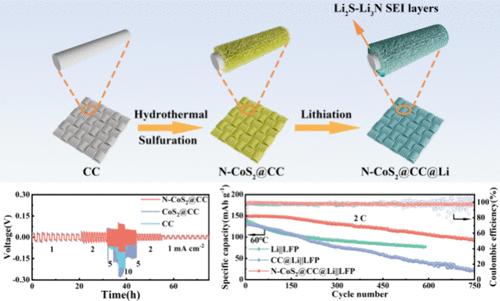当前位置:
X-MOL 学术
›
ACS Appl. Mater. Interfaces
›
论文详情
Our official English website, www.x-mol.net, welcomes your
feedback! (Note: you will need to create a separate account there.)
In Situ Generated Li2S–Li3N Dual Component Protective Layers Enable High Stability for High-Temperature Li Metal Batteries
ACS Applied Materials & Interfaces ( IF 8.3 ) Pub Date : 2024-11-18 , DOI: 10.1021/acsami.4c15229 Chenyang Li, Li Su, Qinglei Wang, Pengfei Zhang, Xuehui Shangguan, Lijun Gao, Faqiang Li
ACS Applied Materials & Interfaces ( IF 8.3 ) Pub Date : 2024-11-18 , DOI: 10.1021/acsami.4c15229 Chenyang Li, Li Su, Qinglei Wang, Pengfei Zhang, Xuehui Shangguan, Lijun Gao, Faqiang Li

|
Li metal has been considered as a promising anode for next-generation high-energy-density Li metal batteries. However, the uncontrollable Li dendrite growth, infinite volume change, and unstable solid electrolyte interphase (SEI) layer cause serious safety issues and poor cycling performances, inhibiting its practical application. Herein, N-doped CoS2 needle-like nanoarrays are decorated on carbon cloth. The N-doped CoS2 nanoarrays with a lithiophilic nature can decrease Li nucleation barriers and induce uniform Li deposition. Furthermore, during the prelithiation process, the in situ reaction between Li and N-doped CoS2 has formed stable Li2S and Li3N dual-component protective layers, which efficiently suppresses the dendrite growth and stabilizes the electrolyte-electrode interface. As a result, the N-CoS2@CC electrode shows an excellent rate performance and a long lifespan of 800 h under a 5 mA cm–2/1 mA h cm–2 electrode with a low overpotential (12 mV). When paired with a LiFePO4 (LFP) cathode, the obtained N-CoS2@CC@Li||LFP cell exhibits outstanding electrochemical performances at the high temperature of 60 °C as well as mass loading of 10 mg cm–2. This work provides a rational approach to constructing a 3D lithiophilic host with stable SEI layers toward practical Li metal batteries.
中文翻译:

原位生成的 Li2S-Li3N 双组分保护层为高温锂金属电池提供高稳定性
锂金属被认为是下一代高能量密度锂金属电池的有前途的负极。然而,不可控的锂枝晶生长、无限体积变化和不稳定的固体电解质界面 (SEI) 层导致了严重的安全问题和较差的循环性能,抑制了其实际应用。在此,N 掺杂的 CoS2 针状纳米阵列装饰在碳布上。具有亲石性质的 N 掺杂 CoS2 纳米阵列可以减少 Li 成核屏障并诱导均匀的 Li 沉积。此外,在预锂化过程中,Li 和 N 掺杂 CoS2 之间的原位反应形成了稳定的 Li2S 和 Li3N 双组分保护层,有效地抑制了枝晶的生长并稳定了电解质-电极界面。因此,N-CoS2@CC 电极在具有低过电位 (12 mV) 的 5 mA cm–2/1 mA h cm–2 电极下表现出出色的倍率性能和 800 h 的长使用寿命。当与 LiFePO4 (LFP) 阴极配对时,获得的 N-CoS2@CC@Li||LFP 电池在 60 °C 的高温下表现出出色的电化学性能和 10 mg cm–2 的质量负载。这项工作为构建具有稳定 SEI 层的 3D 亲锂宿主提供了一种合理的方法,以用于实用的锂金属电池。
更新日期:2024-11-19
中文翻译:

原位生成的 Li2S-Li3N 双组分保护层为高温锂金属电池提供高稳定性
锂金属被认为是下一代高能量密度锂金属电池的有前途的负极。然而,不可控的锂枝晶生长、无限体积变化和不稳定的固体电解质界面 (SEI) 层导致了严重的安全问题和较差的循环性能,抑制了其实际应用。在此,N 掺杂的 CoS2 针状纳米阵列装饰在碳布上。具有亲石性质的 N 掺杂 CoS2 纳米阵列可以减少 Li 成核屏障并诱导均匀的 Li 沉积。此外,在预锂化过程中,Li 和 N 掺杂 CoS2 之间的原位反应形成了稳定的 Li2S 和 Li3N 双组分保护层,有效地抑制了枝晶的生长并稳定了电解质-电极界面。因此,N-CoS2@CC 电极在具有低过电位 (12 mV) 的 5 mA cm–2/1 mA h cm–2 电极下表现出出色的倍率性能和 800 h 的长使用寿命。当与 LiFePO4 (LFP) 阴极配对时,获得的 N-CoS2@CC@Li||LFP 电池在 60 °C 的高温下表现出出色的电化学性能和 10 mg cm–2 的质量负载。这项工作为构建具有稳定 SEI 层的 3D 亲锂宿主提供了一种合理的方法,以用于实用的锂金属电池。


















































 京公网安备 11010802027423号
京公网安备 11010802027423号